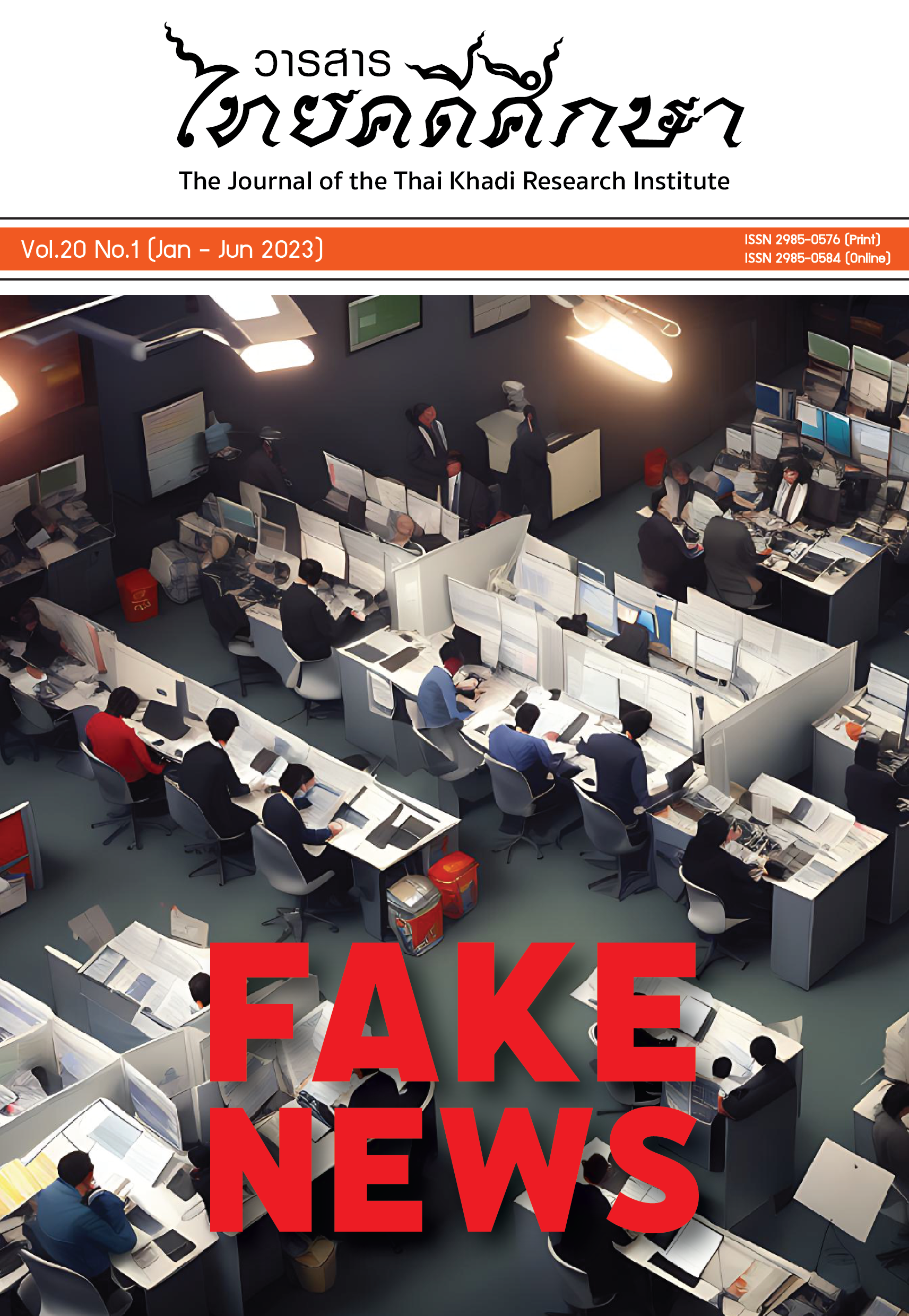Culture is an empirical symbol of ‘prosperity’ acquired by a society through the process of learning and interaction among its members. It is in different aspects, concrete or abstract, and varies from society to society, depending on values given to culture by that society over time. The existence of culture is thus significant to the existence of a society’s prosperity.
Eight articles on different aspects of culture presented in the Journal of the Thai Khadi Research Institute Vol.20 No.1 are as follows:
Television Newsroom Culture in Thailand for Fact-Checking Disinformation by Wilaiwan Jongwilaikasaem. This article studies the working culture of Thai television newsrooms in checking for fake news. Results show that television newsrooms in Thailand still adhere to analog era editorial structure and production process. There is no fact checker to discern real news from disinformation. Fact-checking is primarily the duty of reporters and all editorial office staff. In addition, no television newsroom in Thailand has a defined policy to debunk disinformation
The Use of Shan Language to Represent Shan Identity in Products by Phannida Khanthaphad. This article studies the use of Shan language on the labels of products to signify Shan identity. Results were that Shan language on product labels mostly reflects Shan identity in historical and political aspects; traditions and culture; and nostalgic sentiments. Some other aspects such as love and happy family have been included on product labels recently.
The Concept and Understanding of Thaen in Isan Society: Past and Present by Wuttichai Sawangsang and Puttharak Prabnok. This article studies the concept and understanding of Thaen among Isan residents. Results were that Isan residents originally saw Thaen as a heavenly spirit ranked as the highest deity and creator of the world and mankind. Today, Thaen is still worshiped as an ancestral spirit, known as Phi Fha or Phi Thaen. However, Isan popular understanding of and attachment to Thaen today differs from the past. Six aspects of Thaen are attributable to contemporary Isan residents: belief, tradition, society, lifestyles, literature and poetry. These involve intellectual heritage and cultural capital more than spreading faith and religious teaching.
A Vessantara Jataka Painting Series Dated from 1907 to 1947 by Phetchaburi Craftspeople by Duangkamon Boonkaewsuk. This article presents the identities of a series of Vessanta Jataka paintings produced by Phetchaburi crafts workers in the early twentieth century. These include 13 painting cycle with contents associated with a religious literature, Mahajati Kum Luang, and a painting of the opening scene by Mr. Lert Phuangphradech. Results show that the paintings illustrated Thai traditional painting techniques matched Western styles in adding chiaroscuro and perspective. Adhering to Western styles was more visible in 1932 paintings by Mr. Lert Phuangphradech after his participation in drawing and painting the Emerald Buddha Temple gallery wall.
A Movable Throne Preaching Canopy from Wat Thasalaram in the Thammasat Museum of Anthropology: The Conservation Process and a Reflection on Phetchaburi Preaching Canopy Culture in the Early Twentieth Century by Chanan Mekmak and Mueanphim Suwankart. This article studies Phetchaburi preaching canopy culture in the early twentieth century, focusing on a case study of a movable throne preaching canopy relocated from Wat Thasalaram to the Thammasat Museum of Anthropology for conservation. Results were that the artifact was produced in the first phase of the early twentieth century (1877-1930), reflecting Phetchaburi’s preaching canopy culture among bourgeois religious patrons with its own distinctive artistry differed from the second (1935-1947) and third (1948-1966) phases.
Chaem Bunnag and the Creation of Ton Tamnan Uthai: New Historical Content, Origin of the Thais and Thai Migration from 1889 to 1890 by Nittayaporn Prompanya. This article explores the interplay between historical construction and international context in the late nineteenth century through the study of Ton Tamnan Uthai, compiled by Chaem Bunnag (1864-1907). Results were that the creation of the chronicle was influenced by the author’s work experience in the Anglo-Siamese territorial conflict starting in 1889. In it, he formulated new historical content focusing on the origin of the Tais and Tai migration from Central India and China.
Historical Dynamics of the Thonburi War by Samran Phondee. This article studies the cause, contexts and strategic analysis for tactical wars in Thailand from late Ayutthaya until the end of Thonburi (1703-1782). Results were that the last war between Ayutthaya and Burma leading to the fall of Ayutthaya in 1767 was primarily caused by imperial conceptualization and the problematic ethnic Mon. Throughout his reign, King Taksin waged numerous wars, using varied tactical strategies and a selection of young, knowledgeable, capable and loyal commanders. As a result, in most of the conflicts, his side was victorious.
Power Relations between the State and Islam in Modern Society: A Case Study of Chiang Mai Islamic Organization Administration by Sujinda Kamjorn. This article studies power relations between Thai state and Islam in modern society, focusing on a case study of Chiang Mai Provincial Islamic Council (CMPIC) administration. Findings reveal that the Chiang Mai Governor as representative of the state is legally authorized to accept the Islamic leader and preacher: Imam, Kateb and Bilan. Meanwhile, the CMPIC negotiated with the state to grant Chiang Mai Muslims more social space by electing their Islamic leader who possesses both legal and traditional authority.
Book Review: Anatta, the Soullessness of Nibbana, written by Watchara Ngamchitcharoen, reviewed by Tiamjit Puangsomjit. In this book, nibbana, the key concept in Buddhism, is described from new perspectives, using elaborate discussion and references in making a precise and all-round study of nibbana.
Brief reports on research, academic, art and culture conserving activities organized by the Thai Khadi Research Institute during January and June, 2023 are presented at the end of Journal.
It is hoped that the Journal of the Thai Khadi Research Institute continues to be a forum for disseminating and promoting the study of Thai society and culture among Thai and foreign scholars as well as a source of useful information for readers and the society as a whole.
Published: 2023-06-20


